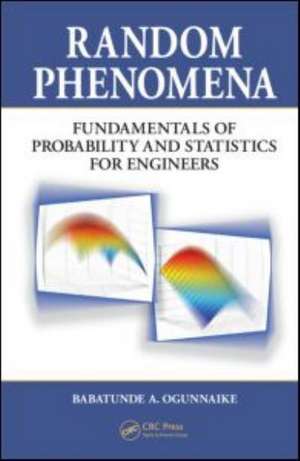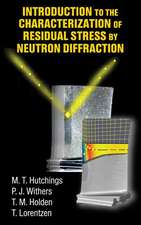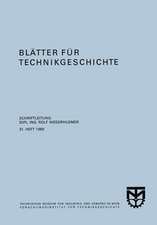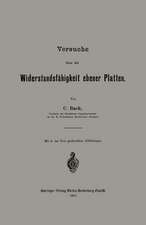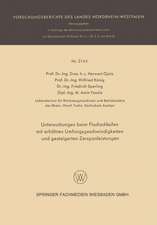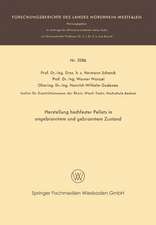Random Phenomena: Fundamentals of Probability and Statistics for Engineers
Autor Babatunde A. Ogunnaikeen Limba Engleză Hardback – 21 sep 2009
Giving students the tools and confidence to formulate practical solutions to problems, this book offers many useful features, including:
About the Author:
Professor Ogunnaike is Interim Dean of Engineering at the University of Delaware. He is the recipient of the 2008 American Automatic Control Council's Control Engineering Practice Award, the ISA's Donald P. Eckman Education Award, the Slocomb Excellence in Teaching Award, and was elected into the US National Academy of Engineering in 2012.
Preț: 1083.44 lei
Preț vechi: 1190.60 lei
-9% Nou
Puncte Express: 1625
Preț estimativ în valută:
207.34€ • 215.67$ • 171.17£
207.34€ • 215.67$ • 171.17£
Carte disponibilă
Livrare economică 24 martie-07 aprilie
Livrare express 08-14 martie pentru 71.89 lei
Preluare comenzi: 021 569.72.76
Specificații
ISBN-13: 9781420044973
ISBN-10: 1420044974
Pagini: 1064
Ilustrații: 193 b/w images, 81 tables and REPLACE TEXT & COVER 2ND PRINTING
Dimensiuni: 156 x 234 x 66 mm
Greutate: 1.63 kg
Ediția:1
Editura: CRC Press
Colecția CRC Press
Locul publicării:Boca Raton, United States
ISBN-10: 1420044974
Pagini: 1064
Ilustrații: 193 b/w images, 81 tables and REPLACE TEXT & COVER 2ND PRINTING
Dimensiuni: 156 x 234 x 66 mm
Greutate: 1.63 kg
Ediția:1
Editura: CRC Press
Colecția CRC Press
Locul publicării:Boca Raton, United States
Public țintă
UndergraduateCuprins
Foundations. Two Motivating Examples. Random Phenomena, Variability, and Uncertainty. Probability. Fundamentals of Probability Theory. Random Variables and Distributions. Multidimensional Random Variables. Random Variable Transformations. Application Case Studies I: Probability. Distributions. Ideal Models of Discrete Random Variables. Ideal Models of Continuous Random Variables. Information, Entropy, and Probability Models. Application Case Studies II: In-Vitro Fertilization. Statistics. Introduction to Statistics. Sampling. Estimation. Hypothesis Testing. Regression Analysis. Probability Model Validation. Nonparametric Methods. Design of Experiments. Application Case Studies III: Statistics. Applications. Reliability and Life Testing. Quality Assurance and Control. Introduction to Multivariate Analysis. Appendix. Index.
Recenzii
The author does an excellent job presenting the material in an interesting way, making connections between theoretical and experimental statistics and between deterministic and probabilistic models. … a good book for engineers. … an excellent introductory mathematical statistics textbook for engineers. I like the fact that the theory is well developed throughout the chapters and that the transition between chapters is smooth. Compared with another introductory statistics resource for engineering (Probability and Statistics for Engineering and the Sciences by Jay Devore), I would choose this text … . I recommend this textbook with full confidence for engineering students who have the strong mathematical background, specifically differential and integral calculus. This book is distinguished from the crowded field by the well-explained theory of statistics and how it provides interesting applications. The big plus about this text is the variety and large amount of review questions, exercises, and application problems that the author provides, which in my opinion is crucial to the understanding of the theoretical concepts.
—Walid K. Sharabati, The American Statistician, August 2011
This book offers many unique features in a crowded field of statistics books for engineers. ... The core concepts are written in an easy-to-understand format and students from various engineering disciplines can easily follow the theoretical concepts presented. The examples and application problems are selected from a wide range that spans catalysts in a chemical reactor, in-vitro fertilization, molecular biology, reliability of parallel computer systems, population demographics, polymers, and finance. … I highly recommend this book for engineering students, professional engineers and applied statisticians dealing with systems involving random phenomena. Instructors who are looking for an alternative textbook should give a serious consideration to adopting this book.
—Ali Cinar, Technometrics, August 2011
The theory is built up from real-life examples from which the first principles are deduced. This works well as it becomes immediately clear that these principles are relevant and useful in practical situations. … The book clearly explains both probabilistic and statistical concepts in minute detail and none of the essentials seem to be missing. All this is done without ever resorting to abstract mathematics, which is quite an achievement. … As an engineer involved in statistical data analysis, I would have loved to be taught from a book like this and I heartily recommend this book as a classroom textbook for both the clarity of the explanations and the amount of material covered. The book further accommodates such use with a large amount of review questions, exercises, application problems, and project assignments. However, the book is also suitable for self-study … . It will allow engineers who have to deal with statistics, but lack sufficient statistical background, to easily gain fundamental insights that are readily applicable in their working environment.
—Pieter Bastiaan Ober, Journal of Applied Statistics, 2011
Introduces the theory by starting from well described engineering examples such that the resulting probability equations appear as the natural outcomes from engineering first principles and not as esoteric mathematics. Engineering significance is then reinforced with discussion of how the results apply to other problems… provide[s] an understanding of why and when statistical methods apply, and equally importantly, when pitfalls lurk. The continual relating of probability and statistics throughout the book is one of its strongest features. … Concepts are clearly explained. A good balance is struck between the providing critical theoretical underpinnings without overwhelming mathematical detail….
Examples from many engineering and science fields illustrate ideas and methods throughout the book, especially in the statistics material. …[presented] examples allow the reader to obtain a sense of the limitations of theory and methods and of the practical judgments required in applications to move to a problem resolution. A useful pedagogical feature is the repeated use of some data sets [on an accompanying CD], allowing students to see how new material provides new understanding.
Although aimed at the textbook market (several syllabus suggestions for 1 and 2-semester undergraduate and graduate courses are given in the Preface), Random Phenomena has much to offer the industrial practitioner. As a chemical engineer who came to statistics out of industrial necessity and not from formal training or a career plan, I found new insights despite more than 20 years of practice, which includes providing internal statistics consulting and training
…all the fundamentals needed for further study in any of its topics are certainly provided. In summary, Random Phenomena is an excellent choice for anyone, educator or practitioner, wishing to impart or gain a fundamental understanding of probability and statistics from an engineering perspective.
—Dennis C. Williams, LyondellBasell Industries, The American Institute of Chemical Engineers Journal (AIChE Journal)
—Walid K. Sharabati, The American Statistician, August 2011
This book offers many unique features in a crowded field of statistics books for engineers. ... The core concepts are written in an easy-to-understand format and students from various engineering disciplines can easily follow the theoretical concepts presented. The examples and application problems are selected from a wide range that spans catalysts in a chemical reactor, in-vitro fertilization, molecular biology, reliability of parallel computer systems, population demographics, polymers, and finance. … I highly recommend this book for engineering students, professional engineers and applied statisticians dealing with systems involving random phenomena. Instructors who are looking for an alternative textbook should give a serious consideration to adopting this book.
—Ali Cinar, Technometrics, August 2011
The theory is built up from real-life examples from which the first principles are deduced. This works well as it becomes immediately clear that these principles are relevant and useful in practical situations. … The book clearly explains both probabilistic and statistical concepts in minute detail and none of the essentials seem to be missing. All this is done without ever resorting to abstract mathematics, which is quite an achievement. … As an engineer involved in statistical data analysis, I would have loved to be taught from a book like this and I heartily recommend this book as a classroom textbook for both the clarity of the explanations and the amount of material covered. The book further accommodates such use with a large amount of review questions, exercises, application problems, and project assignments. However, the book is also suitable for self-study … . It will allow engineers who have to deal with statistics, but lack sufficient statistical background, to easily gain fundamental insights that are readily applicable in their working environment.
—Pieter Bastiaan Ober, Journal of Applied Statistics, 2011
Introduces the theory by starting from well described engineering examples such that the resulting probability equations appear as the natural outcomes from engineering first principles and not as esoteric mathematics. Engineering significance is then reinforced with discussion of how the results apply to other problems… provide[s] an understanding of why and when statistical methods apply, and equally importantly, when pitfalls lurk. The continual relating of probability and statistics throughout the book is one of its strongest features. … Concepts are clearly explained. A good balance is struck between the providing critical theoretical underpinnings without overwhelming mathematical detail….
Examples from many engineering and science fields illustrate ideas and methods throughout the book, especially in the statistics material. …[presented] examples allow the reader to obtain a sense of the limitations of theory and methods and of the practical judgments required in applications to move to a problem resolution. A useful pedagogical feature is the repeated use of some data sets [on an accompanying CD], allowing students to see how new material provides new understanding.
Although aimed at the textbook market (several syllabus suggestions for 1 and 2-semester undergraduate and graduate courses are given in the Preface), Random Phenomena has much to offer the industrial practitioner. As a chemical engineer who came to statistics out of industrial necessity and not from formal training or a career plan, I found new insights despite more than 20 years of practice, which includes providing internal statistics consulting and training
…all the fundamentals needed for further study in any of its topics are certainly provided. In summary, Random Phenomena is an excellent choice for anyone, educator or practitioner, wishing to impart or gain a fundamental understanding of probability and statistics from an engineering perspective.
—Dennis C. Williams, LyondellBasell Industries, The American Institute of Chemical Engineers Journal (AIChE Journal)
Descriere
Many of the problems that engineers face involve randomly varying phenomena of one sort or another. But if characterized properly, even such randomness and the resulting uncertainty are subject to rigorous mathematical analysis. This book provides students with a fundamental understanding of random phenomena and a working knowledge of how to model and analyze such phenomena. It explains how to use probability and statistics appropriately to deal with uncertainty in engineering problems. Basing his approach on the principle of theoretical foundations before application, Dr. Ogunnaike presents a classroom-tested course of study for understanding, characterizing, modeling, and quantifying randomly varying phenomena.
